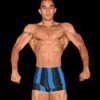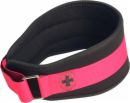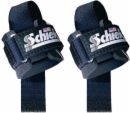First let me start by saying that I try to use as little lifting equipment as possible while working out. Lifting equipment is used to help your body in support and lift heavier-than-normal weight. Powerlifters tend to use these aids more than any other type of lifter. The main reason is because the extremely heavy weight being used makes your body more susceptible to injury. By using specific equipment, you can reduce your chances of bodily injury.
Show Your Workouts The Belt
A weight belt is probably the most common piece of equipment used in a gym. There are many different brands such as Valeo, Everlast, Inzer, etc. that most sporting-good stores sell. Ideally, you want to use a belt while performing exercises that can be rough on your lower back such as squats, deadlifts, and stiff-legged deadlifts.
In addition, I've been told that, by wearing a belt while bench pressing, you can enable yourself to support and press more weight, if done correctly. I don't understand why people tend to wear belts while doing every exercise in their workout, it really is unnecessary because a belt is not needed in order to perform curls or pull-ups, or any other exercise that doesn't put a great amount of stress on the lower back.
In order for a belt to work for you, you need to know how to properly wear a belt. Seems simple, right? The belt is positioned just like any other belt that you've ever worn, right above your hips, and around your waist. You should wear the belt very tightly, but not so tight that you can't breathe. Once the belt is on, suck in a deep breath before you lift the weight off of the rack.
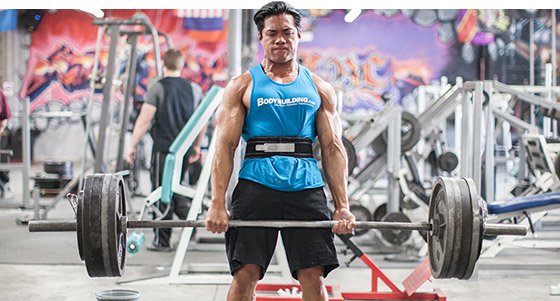
Once you've picked up the weight, let out all your air. Suck in again right before you do a negative. Try to push your stomach outwards as hard as you can so that your stomach and lower back are pushing hard against the inside of the belt. Begin letting out your air on the way up, and then repeat for your next rep.
Personally, I think a belt should only be used when absolutely needed. This means that you should never wear a belt while warming up. Also, if you are going to use a belt, find one that is about 6-8 inches thick and the pressure of the belt is distributed over the entire width of the belt.
Sit Down, Strap In, And Shut Up
Wrist straps are also a very common piece of equipment. Straps are used in order to aid your grip so that you can hold onto heavier weight without it slipping out of your hands. To tell the truth, this is the only piece of lifting equipment that I use. You use straps for exercises such as stiff-legged deadlifts, shrugs, and bent-over rows.
Once again, you only want to use straps when needed; this does not include warm-up sets. Remember to not wear straps when doing exercises that you don't need them for, such as pressing or curling movements. I've actually seen people using straps for movements such as these, and they look like clowns.
It's amazing to me that many people use straps incorrectly; the straps can actually work against you increasing the chance of the weight slipping out of your hands during a set. So listen up; without twisting the strap, run the regular end through the looped end. Now place the strap around your wrist so that the loose end points away from your body and runs directly in line with your pinky.
Now, here is where everyone gets it wrong. Grab the bar normally, and wrap the strap around the bar going underneath the bar first, not over. Once the straps are in place you can tighten them by grabbing the wrapped strap, not too tightly, and roll the bar back towards your body. By doing this, you greatly increase the amount of the weight that you can hold.
Take caution in how tight you wrap the strap is because the tighter it is, the higher the risk of it snapping. Trust me, I've had a strap bust on me while I was shrugging over 600 pounds, and the outcome is no fun.
The Ultimate Wrap Battle
Finally, wrist wraps and knee wraps are usually used by those with weak or injured knees or wrists. Knee wraps are used on squats, and wrist wraps can be used on any pressing movement. By using knee wraps, you give yourself a little bit of spring at the bottom of a squat. This is very useful for powerlifting. I used knee wraps every time I maxed out on squats.
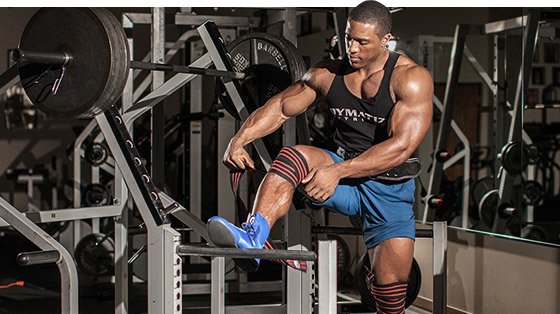
They give your knee extra support, so if you have pain in your knees to the point that you absolutely can't squat, then you might want to look into using them. However, if you can tough it out, then do so. It is important that you put the knee wraps on correctly in order for the outcome to be effective. First roll up the straps like toilet paper.
I always started at the top of my knee and worked my way down. When you are wrapping, be sure to overlap the last wrap by half of its width. You should end up about an inch below the bottom of your knee cap. Once you finish, tuck in the loose end. Don't wrap too tightly because, for one, it's really painful, and two, you don't want your feet to go absolutely numb from absence of blood flow. If you can see any of the skin on your knees between individual wraps, then you wrapped incorrectly. Try overlapping a little bit more.
Wrist wraps are very simple. Before performing a pressing movement, wrap your wrists as tight as you need. If your wrists don't stay straight, wrap tighter. Many people limit their use wrist wraps for heavy weight on bench press mainly.
As stated earlier, many people use this equipment for the wrong reason, and use it incorrectly also. The downfall to using these items is that you weaken the muscles that you are aiding. For example, using a belt weakens your lower back strength, and using wrist straps decreases your grip strength. This is the main reason why you want to use aids only when absolutely necessary.
